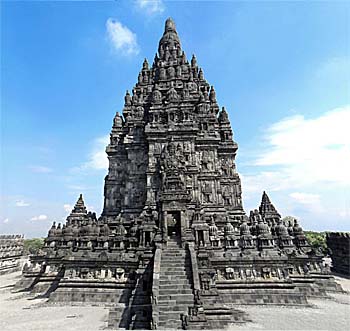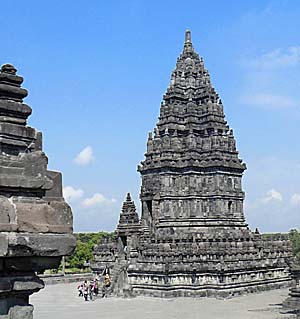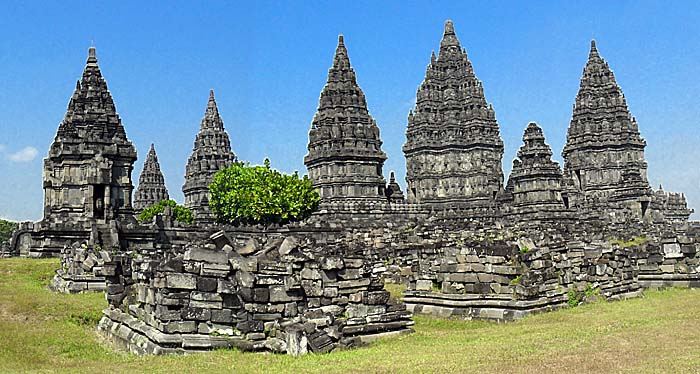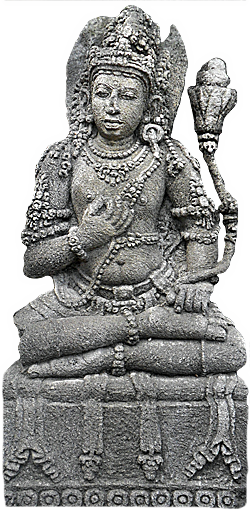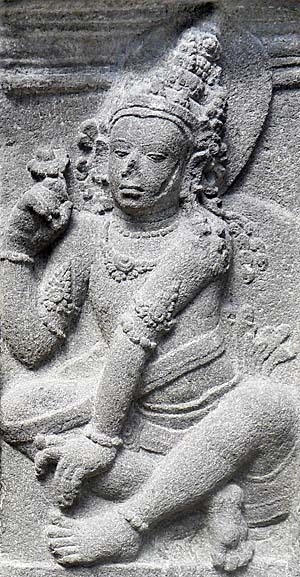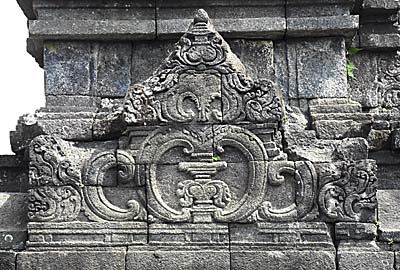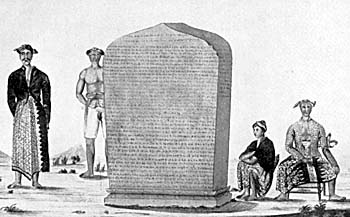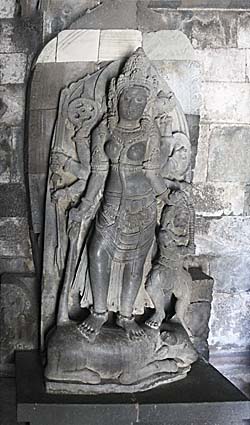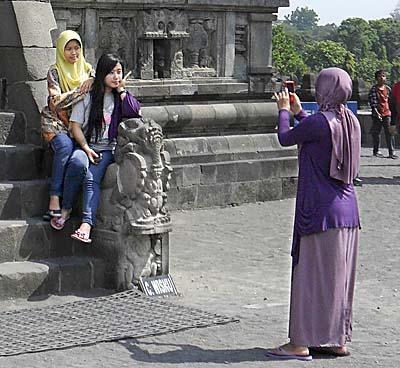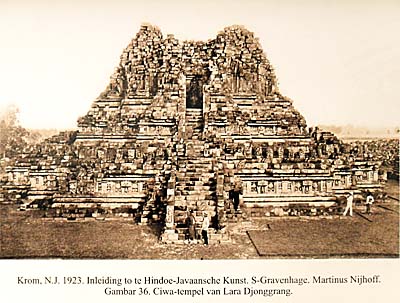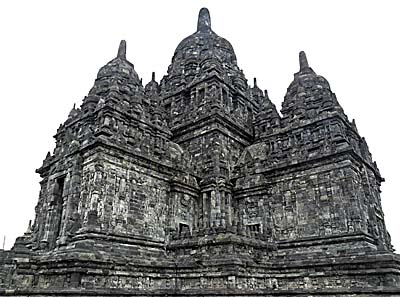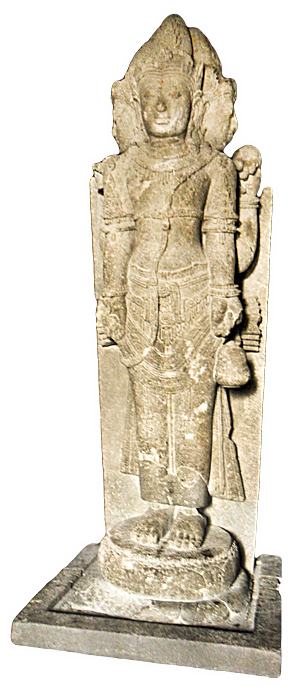2.
The Architectonical
Concept of
Prambanan Temple Compound
Prambanan Main Temple Compound
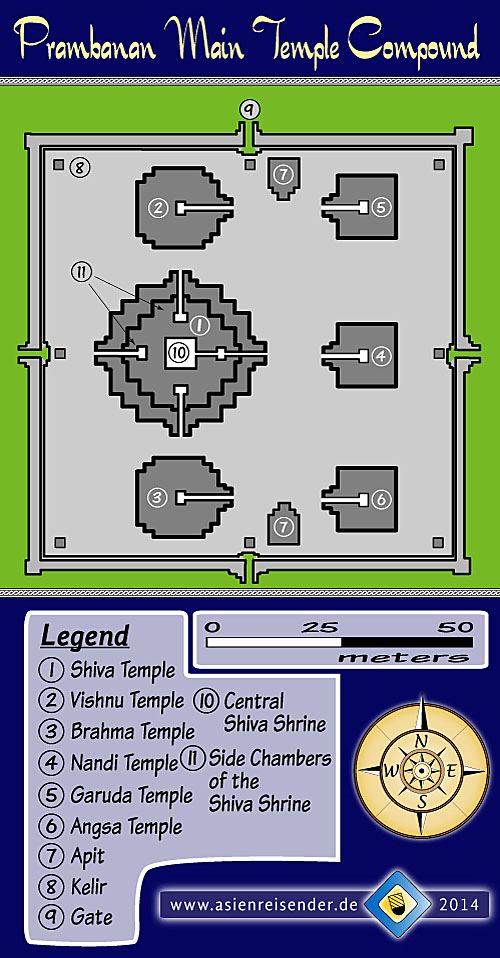
The inner, central temple area. It's the most sacred, important and representative part of the sight; most of the restoration efforts concentrated on it. However, there is further restoration planned for the middle area as well. Besides, Candi Sewu and the two smaller buddhist temples within the archeological park got also some restoration.
The grand temple city of Prambanan was built from 850 CE on. The building phase stretched probably, as it was also the case with nearby Borobodur, over a few decades. The ruling kings of the time were king Pikatan and his successor king Balitung.
The Archaeological Park of Prambanan is of a considerable size. One has to walk several kilometers to come around here. For those with foot-aches there is a small trainlike vehicle with a kind of [electrical] locomotive and some cars for passengers. It's commuting between the park entrance and the various sights in the park, until the very north of it, Candi Sewu.
Within the archaeological park, west of the Prambanan temple compound and across the Opak River is an open-air theatre, a larger stage for promoting the Ramayana epos at night.
The site of Prambanan is divided into three different zones. Although Prambanan is, in difference to Borobodur, a hindu sanctuary, it's following partially similar concepts. One of them is the purity of spirituality. The pilgrimage from bottom to top of Borobodur is a spiritual voyage from the primitive, earthy being to a purified, spiritual being of enlightenment. Although enlightenment plays no role in hinduism, the concept of Prambanan is also following the ideal of spiritual purification. The outer area is for 'normal' beings with all their failures, the middle section is already for advanced beings with a considerable spirituality, while the inner, central platform is exclusively for the highest spirits, the gods, the high priests, the king and his family, ministers and inner circles.
Prambanan Temple Compound
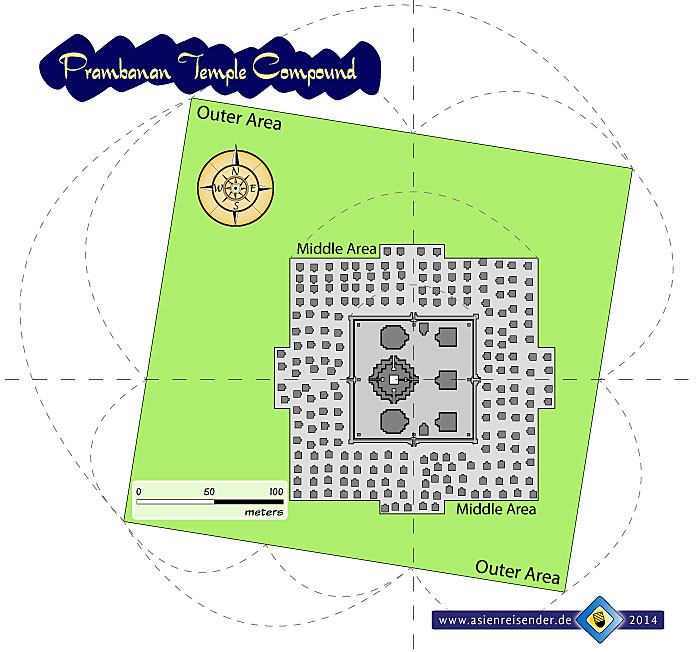
The three areas of Prambanan Temple Compound. Remarkably, the outer area is, although squareshaped as the two inner areas, aligned in a different angle. Since there are no buildings in the outer area left, the outer area as such doesn't exist anymore.
Map of Prambanan Archaeological Park
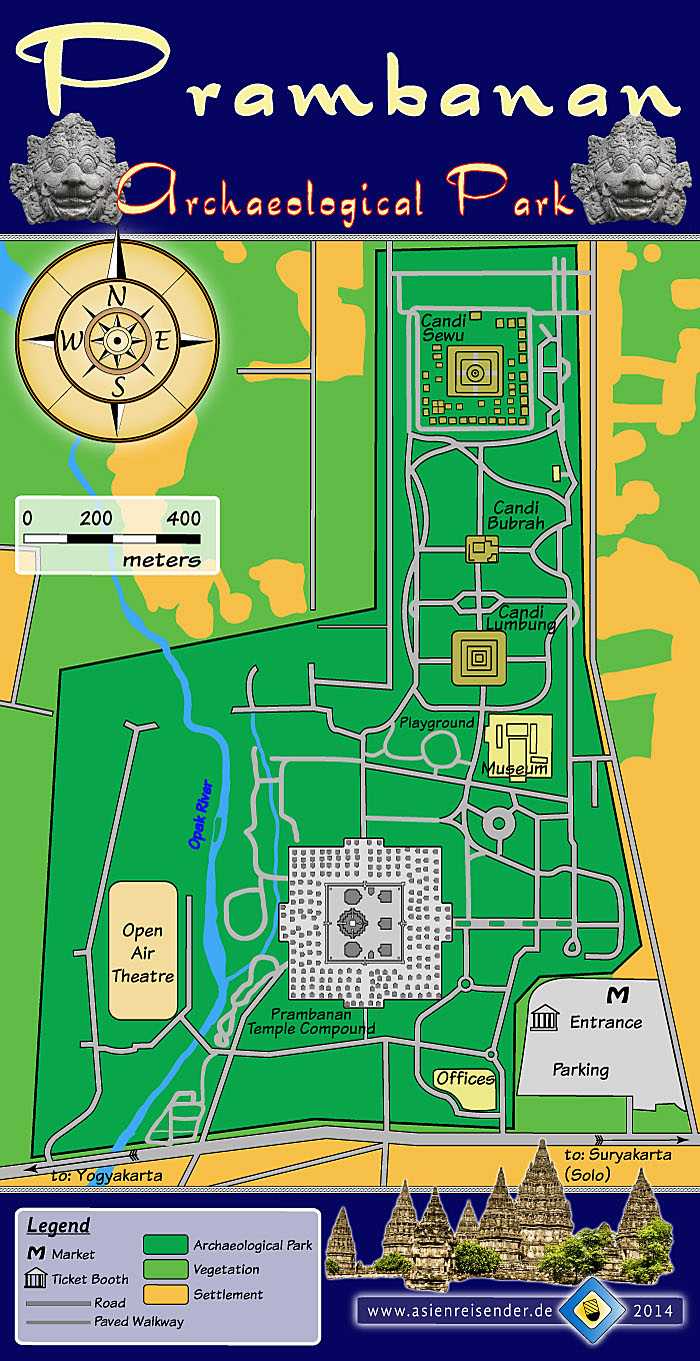
Prambanan Archeological Park is an area of a considerable size. Best to explore it is, as always, by walking. Therefore one should take his/her time. It's defenitely worth to come here more than one time, because there is so much to explore that it's too exhausting for one visit. Besides it's always a pleasure to see such great sights in different lights and weathers.
Beside of Prambanan Temple Compound itself there are three other temple sites in the Archeological Park. The largest is buddhist Candi Sewu, older than Prambanan and also a big temple compound, which originally consisted of hundreds of temples. Candi Lumbung and Candi Bubrah are smaller and both in a comparable poor state of restoration.
Interestingly, it seems that the Opak River has been altered in his course by the builders of the monuments. A waterwork project has been mentioned on the Shivagrha inscription, where Prambanan is described. Originally, the river run more eastward, close along the temple compound.
The park is enclosed by a fence of about 1.90m height. The entrance fee in the mid 1990s was very low, but rose massively in the meantime; in May 2012 it was 15 US$ for a foreigner, for Indonesians merely a part of it.
The Central Platform
The central part or platform of Prambanan was the most sacred part of the compound. It's assemblage consists of eight bigger temples.
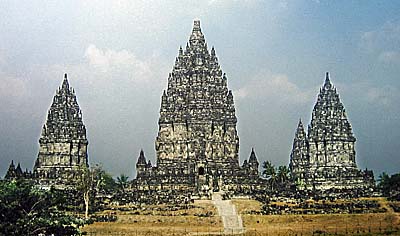
Here one sees the levelling approach to the inner square. A huge amount of foundation material must have been transported to the site to shape this landscape. The tall building is, of course, Candi Shiva again.
Image by Asienreisender, 1996
The three main temples, Trisakti, are built in an exact north-south alignment. The central main temple, Candi Rara Jonggrang, was dedicated to Shiva, the inventor of new things, but also a great destroyer (maybe according to neighbouring Mount Merapi, who destroys frequently surrounding lands but creates and feeds new life due to his fertile volcanic ashes). The impressing height of the main monument is 47m with a square base of 35m each side. Candi Rara Jonggrang is ornamented with a number of reliefs who show episodes of the hindu epic Ramayana. In the main chamber is a statue of Shiva placed, in four smaller sidechambers are statues of Shiva's wife Durga, Shivas teacher Agastya and Shiva's son, the elephant god Ganesha. Deep inside the Shiva temple there was an urn found together with quite a variety of funeral adjuncts.
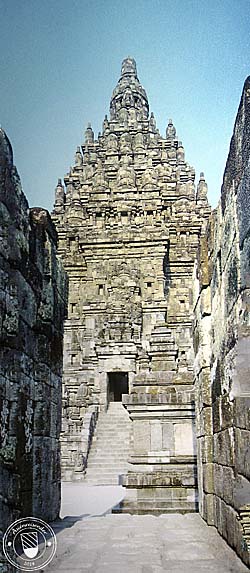
The entrance to one of the side chambers of the Shiva temple Rara Jonggrang. In 2012 access was denied due to danger of (partial) collapse, an aftermath of the 2006 earthquake.
Image by Asienreisender, 1996
North of Rara Jonggrang stands the Vishnu temple. Although it's clearly smaller than the main temple it's still of an impressive height of 34m and a base square of 19m each side. There is only one chamber inside where a statue of Vishnu is erected. A sequence of bas-reliefs on Vishnu temple depict the story of lord Krishna from the Bhagavata Purana epos.
The southern one of the three main temples is that of Brahma, the creator. He is of the same size as the Vishnu temple and houses as well a single statue, and you won't guess it, it's Brahma himself.
These main temples are placed on the central platform, together with three more, but smaller secondary temples. This main platform is square-shaped and each of it's sides is 222 meters long. One approaches it by climbing some steps up, entering one of four gates. Only the northern gate is restorated, the other three gates are broken. At the wall of the eastern gate more reliefs, who depict the Ramayana epos, start and span all around the inner area. The relief panels have to be read in a clockwise direction.
The three 'secondary' temples opposite the main temples who are dedicated to the three central hindu gods, serve as shrines for the gods vehicles. Nandi temple, opposite the Shiva temple Rara Jonggrang is the housing for Vahana, the devine bull. Vahana appears in company with two more deities in Candi Nandi, that's Chandra and Surya.
The temple opposite to the Vishnu temple was probably housing a garuda, but it's empty now. Generations of tomb raiders took out what they wanted.
The vehicle of Brahma is Angsa (also: Hamsa), a swan who appears also often in hindu and buddhist temples. Certainly in the shrine of the temple opposite to Brahma there was once a statue of Angsa/Hamsa placed, but now it's empty as well.
The central platform or inner area is the most sacred part of the whole temple compound. To mark it's importance it's surrounded by a wall with the mentioned four gates. It's the gods habitate, and only exclusive, privileged members of the medieval Prambanan society were supposedly allowed to enter it. Additionally it was certainly a highly ritualized event to visit the divine platform.
Prambanan, North Gate
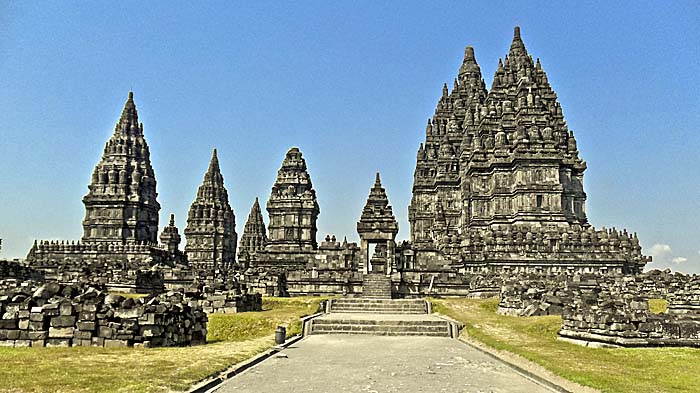
Prambanan, approaching the main platform from the north. The northern gate is the only of the four gates which is restorated. The main temples at the right side are the Vishnu and Shiva temples; the Brahma temple is covered behind the main one. Left side one sees the complementary temples for the gods mystical animal vehicles.
Image by Asienreisender, 2012
The Middle Area
The main platform as the center of the whole complex is surrounded by a middle part, where in former times 224 temples of smaller sizes were built in four rows. These shrines were made in an identical style. Row for row, approaching the inner area, are slightly elevated. Since hinduism is a strict caste system, it's possible that the four different elevations reflect the hindu casts. The temples of the middle area are called Candi Perwara, what means somewhat like guardian temples. Now there are merely stone heaps where once the buildings were. Only two of them are reconstructed, while the remains of all the others are tidily piled up at their places. The middle area was the space for askets and lower gods. Hinduism is so very, very rich in different gods; many of the smaller gods are local gods who don't appear elsewhere in the hindu world.
It's thinkable that in the heyday of Prambanan the middle area with all the smaller monuments was partially inhabited by Brahmans.
Prambanan Temple Middle Compound
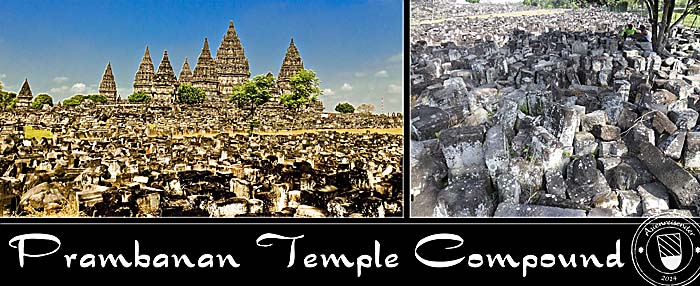
The middle part of Prambanan Temple Compound, as it looks now, after numerous earthquakes. Merely debris is left. At least two of the 224 monuments of the middle area are reconstructed. One of them is to see in the left picture, left edge.
Images and photocomposition by Asienreisender, 2012/2014.
The Outer Area
All the three areas are square shaped. Around the middle part is a wider space, aligned in a remarkable, differing pattern, which was dedicated to the commoners, animals and daemons. It's for those who stick to physical desires, who lead an unspiritual way of life. That's then, 'naturally' the commoners, who are not part of the elitarian classes. The boost of religious monuments came certainly along with a stricter hierarchical structuration of the ancient Javanese society.
A Relief of Prambanan
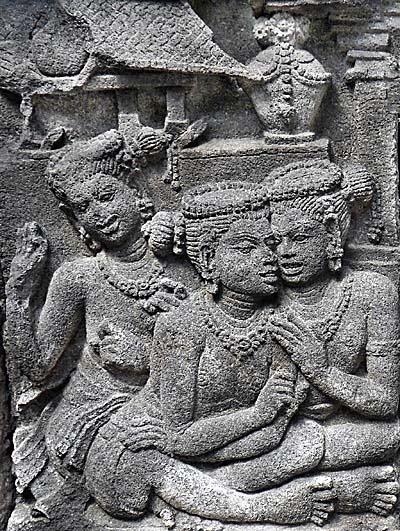
Servants in the bas reliefs of Prambanan. They are easily recognizable by their haircut. Numerous details are worked into the fresco. The building in the background looks like a simple dwelling.
Image by Asienreisender, 2012
Although the nobles of the time are seen as rather modest leaders, their effort was doubtlessly to strengthen their authority. The medieval Javanese society became certainly (much) more hierarchical due to all the monuments and the rituals applied on them. The priest cast must have grown very much to keep all the temples in service. What did that mean to the peasantry? They still had to feed the growing clergy and nobility, and many must have been involved also in the hard work. The legitimation pattern of the ruling feudal class was their close relation to the divine beings and the interpretation of their 'will'. A king was king because the gods made him king (divine right) or, moreover, was himself anyhow godlike. And all the impressing buildings and the rituals served as a proof for their 'righteous' rule.
As well as in Borobodur we don't find any hints for slavery in this culture; what does not mean there weren't slaves.
In ancient times, when Prambanan was a living culture, there were certainly buildings and maybe housings of people in the outer area who had anything to do with the construction, maintaining or ritual functions of the sacred place. Since these buildings were made of organic materials, they are gone. Still, there should be traces left...?!
Around the Prambanan temple compound are more temples in the wider area. Among them are even buddhist temples, as the 2 kilometer away Candi Sewu, still within Prambanan Archeological Park.
